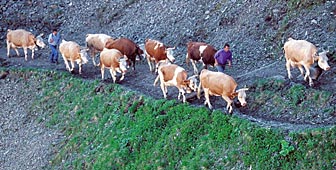Alpine farming giving way under competition pressures

The life of Switzerland's mountain farmers is changing out of all recognition, according to a study by the federal institute of technology in Zurich.
Economic pressure is forcing mountain farmers to give up milk production and to rear cattle for meat. The change means that farms are getting bigger while their numbers are declining.
“The way the land is used will also have ecological consequences,” warned project manager, Nikolaus Gotsch. “There will be more pasture instead of the cutting of hay and this may have consequences on biodiversity and also on soil erosion problems in mountain areas.”
The five-year project incorporates ten doctoral theses looking at different aspects of sustainable forestry and agriculture in the Alpine region.
Question of definition
What actually constitutes a mountain farm is not easy to define. According to the Swiss federal office for agriculture, criteria include altitude, climate, vegetation, accessibility and proximity to infrastructure.
Several thousand farmers fall into this category. On average, they own about 15 hectares with about 20 milk cows. The study says farm size will have to double within the next ten to 15 years to remain economically competitive.
“Prices will go down with the integration of Switzerland in the European market and in the world market,” Gotsch told swissinfo.
“There will be less protection for our agriculture sector and at the same time production costs and particularly labour costs will increase.”
Milk to meat
The shift from milk production to a more extensive meat production has several implications.
With animals on permanent pasture, being raised for fattening, the income per hectare is half that produced by dairy cattle.
Some farmers will go out of business. Gotsch said the rate would be much higher than the 2.5 per cent disappearance, which has been seen from generation to generation over the last 60 years.
The federal office for agriculture is already encouraging farmers to look at alternative ways of generating income.
Toll on tourism
The changes will also have an effect on the traditional Swiss landscape, much loved by tourists, with its mix of pasture, cultivated hay meadows and forests.
The abandonment of agricultural land and the alpine pastures is going hand in hand with an expansion of forests and shrubs in mountain areas.
“Our farmers and our foresters are cultivating the raw material for our tourist industry,” Gotsch told swissinfo.
“There are lots of tourists coming to the Swiss mountain area and we have to take care not to produce a landscape, which is not accepted by them.”
Gotsch said the report was designed to inform policy makers and farmers and prepare them for the changes ahead.
Its publication comes ahead of a week-long international conference on sustainable agriculture and rural development in mountain regions, which begins in Adelboden on Sunday.
by Vincent Landon

In compliance with the JTI standards
More: SWI swissinfo.ch certified by the Journalism Trust Initiative
You can find an overview of ongoing debates with our journalists here . Please join us!
If you want to start a conversation about a topic raised in this article or want to report factual errors, email us at english@swissinfo.ch.